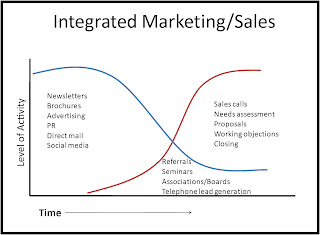Check out this interesting article about how to more effectively move opportunities from the top of your sales funnel to the bottom by employing these nurturing techniques in the middle.
A Guest Post by Alan Vitberg, Owner, VitbergLLC
Combine Telemarketing with Marketing Automation for a Powerful 1-2 New Business Punch
We’re reading and hearing more about the leadership at professional services firms saying that top line growth is their key objective for 2012. So, they’re either asking partners to take more accountability for developing relationships and working their contacts for new business opportunities, or they’re turning to inbound marketing and outbound marketing techniques like telemarketing to fill the top of the sales funnel.
But the real test of new business development not only comes at the top of the funnel, but how effectively the firm nurtures leads in the middle of the sales funnel. According to a recent study by Marketing Sherpa, 79% of marketing leads never convert into sales. Yet, other studies like the one done by DemandGen Report show nurtured leads produce on average a 20% increase in sales opportunities versus non-nurtured leads.
As much as managing and niche practice partners would like to think that prospects are pacing the floor awaiting their call, the fact is that most leads acquired with top of the funnel marketing activities just aren’t sales ready. In fact, about 8 out ten prospects just aren’t ready to sign a contract after one touch, regardless of the strength of your company or personal brand. But, according to Marketo, an average of 20% of leads that are nurtured will convert to sales-ready leads within 12 months.
That’s a powerful argument for professional services firms to consider a dedicated lead nurturing program, and one of the most powerful nurturing programs you can construct will come from combining telemarketing touches with touches delivered through marketing automation technology.
Marketing automation is executed using software that reduces repetitive tasks associated with marketing processes, including customer segmentation and campaign management. One of the key benefits of automation in lead generation is the ability to set up a campaign that automatically sends messages to prospects on a regularly scheduled basis. Another key benefit is the ability of the automation software to track responses, both at the campaign level and at a level that identifies if the prospect has engaged with the campaign by opening or clicking though a message.
To make a lead generation and nurturing campaign successful, personal need to be woven into the campaign schedule, and that’s where telemarketing can and should play an important role. Start with a campaign plan that includes a two or more offers (i.e. whitepapers, seat at a webinar), landing pages on your web site supporting the offers, and the outbound and inbound marketing tactics you’ll use to deliver the offer. Telemarketing can play an important role in the outbound promotional components of the plan.
So here’s how a lead nurturing process can be executed by integrating automation with telemarketing:
1. Touch 1: Prospect is driven to a landing page where they complete a form in order to get an offer (i.e. “free whitepaperâ€). Consider using telemarketing at this point to inform prospects of the offer and where and how they can redeem the offer.
2. Touch 2: An automated thank you response is delivered to the prospects
3. Touch 3: Use telemarketing to make an introductory phone call to the prospect, with the objective of exploring their issues
4. Touch 4: 30 days later, send an automated e-mail with a case study
5. Touch 5: 45 days later: send the prospect another offer (i.e., a webinar) that requires an action, like filling out a form again. This should be set up and automated at the beginning of the campaign and triggered by time after first contact
6. Touch 6: Make a phone call to personally invite the prospect to redeem the offer
7. Touch 7: 60 days later: send an automated invite to the prospect inviting them to subscribe to your blog
8. Touch 8: 75 days later: call for an appointment
The combination of telemarketing with automated marketing touches can be a powerful combination for nurturing prospects though the sales funnel. These campaigns need to be designed and timed and fully complete even before the first outbound or inbound promotion is launched, and along the way, measuring conversion rates of leads to qualified leads to sales ready leads is a prudent step as it will provide insights as to effective techniques and approaches for future campaigns.
Alan Vitberg is owner of VitbergLLC, a marketing agency that works with professional services firms, specializing in inbound marketing, internet marketing and lead generation. He can be reached at avitberg@vitbergllc.com or at (585) 425-2552.

